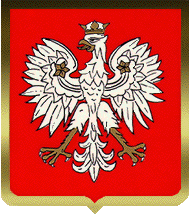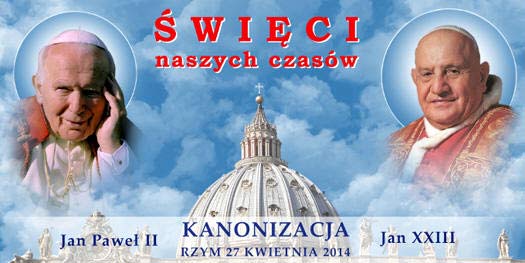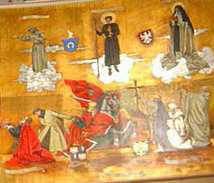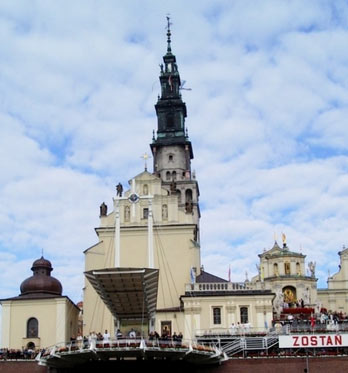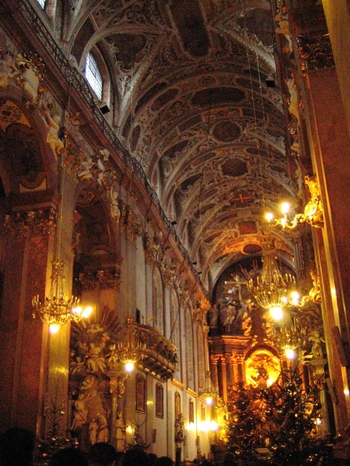History
According to tradition, the icon of Jasna Góra was painted by Luke the Evangelist on a tabletop built by Jesus himself, and the icon was discovered by St. Helen, mother of Emperor Constantine and collector of Christian relics in the Holy Land. The icon was then enshrined in the imperial city of Constantinople, according to the legend, where it remained for the next 500 years.
![]() Icon of Our Lady of Częstochowa
Icon of Our Lady of Częstochowa
In 803, the painting is said to have been given as a wedding gift from the Byzantine emperor to a Greek princess, who married a Ruthenian nobleman. The image was then placed in the royal palace at Belz, where it remained for nearly 600 years.
History first combines with tradition upon the icon's arrival in Poland in 1382 with a Polish army fleeing the Tartars, who had struck it with an arrow.
Legend has it that during the looting of Belz, a mysterious cloud enveloped the chapel containing the image. A monastery was founded in Częstochowa to enshrine the icon in 1386, and soon King Jagiello built a cathedral around the chapel containing the icon.
However, the image soon came under attack once again. In 1430, Hussites (pre-Reformation reformers) attacked the monastery, slashed the Virgin's face with a sword, and left it desecrated in a puddle of blood and mud.
It is said that when the monks pulled the icon from the mud, a miraculous fountain appeared, which they used to clean the painting. The icon was repainted in Krakow, but both the arrow mark and the gashes from the sword were left and remain clearly visible today.
The miracle for which the Black Madonna of Częstochowa is most famous occurred in 1655, when Swedish troops were about to invade Częstochowa. A group of Polish soldiers prayed fervently before the icon for deliverance, and the enemy retreated. In 1656, King John Casimir declared Our Lady of Częstochowa "Queen of Poland" and made the city the spiritual capital of the nation.
The Virgin again came to the aid of her people in 1920, when the Soviet Russian Red Army gathered on the banks of the Vistula River, preparing to attack Warsaw. The citizens and soldiers fervently prayed to Our Lady of Częstochowa, and on September 15, the Feast of Our Lady of Sorrows, she appeared in the clouds above Warsaw. The Russians were defeated in a series of battles later dubbed the "Miracle at the Vistula."
During Nazi occupation, Hitler prohibited pilgrimages to Jasna Góra, but many still secretly made the journey. In 1945, after Poland was liberated, half a million pilgrims journeyed to Częstochowa to express their gratitude. On September 8, 1946, 1.5 million people gathered at the shrine to rededicate the entire nation to the Immaculate Heart of Mary. During the Cold War, Jasna Góra was a center of anti-Communist resistance.
Pope John Paul II, a native of Poland, was a fervent devotee of the Virgin Mary and of her icon at Częstochowa. As pope, he made pilgrimages to pray before the Black Madonna in 1979, 1983, 1991, and 1997. In 1991, he held his Sixth World Youth Day at Czetochowa, which was attended by 350,000 young people from across Europe.
Other popes have honored the "Queen of Poland" as well. Pope Clement XI officially recognized the miraculous nature of the image in 1717 and in 1925 Pope Pius XI designated May 3 a feast day in her honor. Pope Benedict XVI visited the shrine on May 26, 2006.


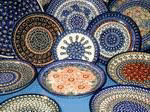




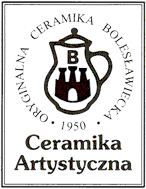 View Pottery for Sale
View Pottery for Sale 
 Ceramika Artystyczna has won numerous awards for artistic design and quality. There is a difference in pottery: this particular pottery is made of whiter, denser clay and incorporates more intricate designs and shapes. The quality of Ceramika Artystyczna's glazing is unsurpassed. All pieces have the artist's initials or are signed by the artists. The coffee pot with Castle mark on the bottom of each piece (or the former mark of the Castle with "B" on top) represents pottery from Ceramika Artystyczna.
Ceramika Artystyczna has won numerous awards for artistic design and quality. There is a difference in pottery: this particular pottery is made of whiter, denser clay and incorporates more intricate designs and shapes. The quality of Ceramika Artystyczna's glazing is unsurpassed. All pieces have the artist's initials or are signed by the artists. The coffee pot with Castle mark on the bottom of each piece (or the former mark of the Castle with "B" on top) represents pottery from Ceramika Artystyczna. 
